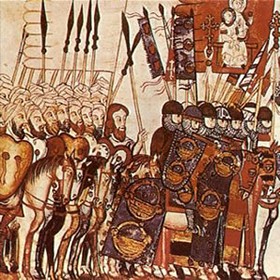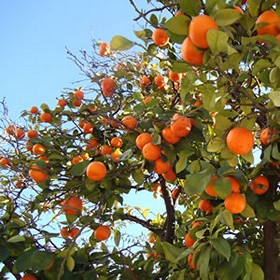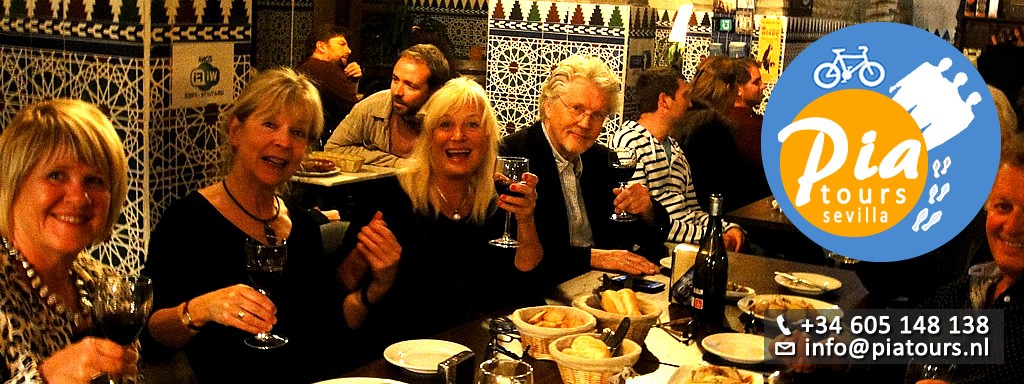


Page index:
• General
• Neighborhoods
• Climate, temperature, weather
• Culture and history
• Mudéjar style
• Via de la Plata
• Orange trees
• How many days Seville?
• Seville as film set
• More about Sevilla

General Touristic Information Seville
Seville is absolutely the most authentic, yet undiscovered jewel of Spain. It is both the capital of Andalusia, the southernmost autonomous region of Spain, and of the province of Seville. The city is situated along to the largest river in Spain, the Guadalquivir, where in 1492, Christopher Columbus left with his ship, the Santa Maria, assuming he discovered a new route to India. It became the 'New World' as we now know as America.
After Madrid, Barcelona and Valencia, Seville is Spain's fourth largest city with over 700,000 inhabitants. But with the big conglomeration the total comes to a small 1.5 million people.
💡 Seville suitable for people with disabilities?
Did you know that we have successfully organized complete programs for people with disabilities or wheelchairs?

Cosy neighbourhoods and districts Seville
Seville city (without the conglomoraties) consists of 11 districts with within these districts 108 neighborhoods (los barrios). The three best-known districts Casco Antiguo (the old city centre), Macarena (only the old part) and Triana (former district of the gypsies where also the famous Flamenco dance style was born. The most famous neighborhood in Casco Antiguo is Santa Cruz, the historic former Jewish quarter (Judería) with its many stories and legends. Here you can wander or stroll through the narrow, idyllic alleyways with many (touristic) shops, bars and restaurants.
💡 City map Seville
Click here to download the city map of Seville with the most famous landmarks and highlights (Casco Antiguo and the familiar surrounding neighborhoods).

Climate, temperature and weather Seville
In summer the temperatur in Seville can easily more than 40 degrees celcius (104 degrees Fahrenheit. Therefore is Seville one of the most hottest cities in Europe! It is absolutely not the humid heat, as in the most European countries, Canada or the norther American states, but it is a very dry climate which makes 40 degrees celcius feels like 30 degrees celcius (86 degrees Fahrenheit). With only 21 days of rain per year you have a lot of sunshine per year! Spring and autumn have a very pleasant climate. For many, the most ideal, moment or time for a city trip to Seville. But do not forget the winter because a temperature of 15 degrees is not an the exception! The month of January is the coldest of the year and in February/March falls the most rain.
Are you in Seville or Andalusia during the summer months? Then do just like the Sevillians and adjust to the warm climate. This means getting up early to do some activities. Around 2 p.m. you have a (rich) lunch and then you do nothing (siesta) or look for the coolness until around 6 p.m. or later. At this time the Sevillians will come alive again to enjoy live till in the late cool hours.

Rich culture and history of Seville
Seville originated about 3,000 years ago and was lying then even at the the sea. The mix of influences from previous occupants such as the Romans, the Moors and later the Catholics made a beautiful city full of history and culture. Seville has the oldest and the largest historical center of Europe. A huge open-air museum. The most beautiful and famous sights of very old to very modern, are within walking distance. Think include the Plaza de España, the Real Alcázar with its beautiful gardens, the Cathedral with its Giralda (tower and former minaret) and the futuristic, wooden structure, the Metropol Parasol.

Mudejar style in Seville
The Mudejar style (Spanish: estilo mudéjar) is only in Spain and can be described as an art style in which Muslim and Christian art forms are merged. It is the result of the merging of two artistic traditions: the Islamic on the one hand and the Christian tradition on the other.
Spain knew Islam presence and domination from 711 to 1492. From the eleventh century weakened the power of the Muslim rulers. At the Reconquista - from the 2nd half of the 11th century - recaptured Christian monarchs the Muslim areas. Besides the political and social consequences of this reconquest wars was the arose of cultural contacts between Christians and Muslims. These contacts are the foundation of the famous Mudejar style. There developed a mudejar architecture, also decorative arts, literature and especially in the period mid-13th century - end of 15th century (250 years).
Source: Wikipedia

Via de la Plata (Santiago de Compostela)
Seville is also the starting point for those who want to hike, bike or on a motorcycle ride the famous Via de la Plata. This is the longest pilgrimage of Spain which runs from Seville to Santiago de Compostela (± 1,000 km.). Significantly lesser known than the pilgrimage Camino Francés (in 2015: ± 9000 Pilgrims versus ± 260,000 Pilgrims through the Camino Francés). Via de la Plata was in the early Middle Ages the main route to Santiago de Compostela for Christians which came from the south of Spain dominated by Muslims. The robust and rustic journey goes through vast and arid areas, with plenty of ancient roads built by the former Romans.

Many orange trees in Seville
The many orange trees give you a truly subtropical feeling right in and around the vibrant centre of Seville. According to the latest counting, there are in the city of more than 45,000 orange trees. In the spring you can smell all over Seville delicious, the soft blossom scent while in the winter the night is filled with the sound of falling oranges on parked cars. The first are ever planned by the Moors in order to provide the main routes of shadow and in the case of extreme dryness to eat the acid bitter oranges for the moisture. Today, the oranges after the harvest in February/March are transported to England where the famous sweet bitter marmalade is made of. The rest is processed into compost for agriculture.

How many days Seville?
The amount of days for Seville obviously depends how extensively you want to see and get to know the city during your break. Our experience is that people who thought they could do Seville in a day come back for another and longer visit. All were charmed by the splendor and magnificence of this city. Our advice? Make sure you have at least three full days to spend and let you be 'pampered' by Seville. Not only by its beauty but also because of the good food, drink and folklore. Seville is not for nothing the birthplace of the tapas and flamenco! Will you do all right? Start first with a memorable or bike tour or walking tour. Don't forget of course, the engaging Flamenco dance style.

Seville as movie set or film set?
Not only tourists discover the beauty of Seville as the city is for various media, movies, songs and occasions a beautiful backdrop. For example:
• Did you know that the Dutch King Willem Alexander and Queen Maxima have met here in 1999 at the
Feria de Abril?
• That for the successful serie Games of Thrones, the
Real Alcázar and
Plaza de España
have served as a backdrop for the filming of season 5 (in Oct. and Nov. 2014)?
• Plaza de España is a popular film set. In 1962 it was used as the setting for 'Cairo Great Britain
Army Headquarters' in Lawrence of Arabia. Also as a film set for 'Naboo' in Star Wars: Episode II - Attack of
the Clones in 2002. In 2012, used as a backdrop in the movie 'The Dictator'?
• The pop group Simply Red recorded their clip for the hit
Something got me started in Seville
(1991)?














